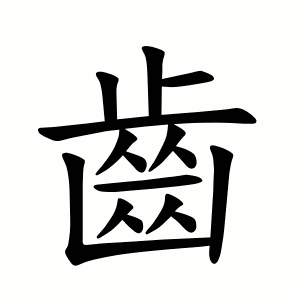齒
- tooth;
It refers to the organ inside the mouth of vertebrates used for biting or chewing food.
Etymology
Originally, 齒 was a pictograph representing visible teeth inside an open mouth.
Later, it was turned into a phono-semantic compound, with 止 (ji, “to stop”) added on top to provide the sound.
Usage in Korean
The meanings of 齒 extend beyond just “tooth”:
1. It can refer to animal teeth, especially ivory.
2. It can also describe tooth-like objects, such as saw teeth or rows of evenly spaced items.
Since horses and cows grow one tooth per year, it was historically used to indicate their age—and eventually came to be used for human age as well.
When used as a radical, 齒 conveys meanings related to teeth or dental features.
Examples:
齡 (나이 령, age)
齧 (갉을 설, to gnaw or nibble)
齦 (잇몸 은, gums)
Additional notes
Characters with 齒
Words that derived from 齒
- 卜一山人人 (YMUOO)
- ⿱ 止 𠚕
